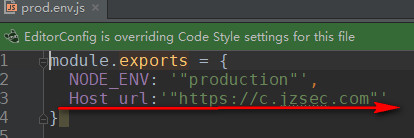原文地址:
http://www.cnblogs.com/JimmyBright/p/7307486.html
通常應用程式上線都會經過開發環境、測試環境、生產環境三個階段,三個環境通常會對應有三個不同的後端api地址或者其他的配置項。下面主要記錄怎麼把不同的配置項釋出到不同的執行環境裡邊。
開啟vue專案找到config目錄,vue-cli生成的專案下有 dev.env.js index.js prod.env.js test.env.js四個檔案
假設三個環境對應三個不同的介面訪問的url字首。



在需要訪問介面地址的地方
alert(process.env.Host_url)
這樣還並不能取到不同環境下的Host_url
點開config下的index.js
1 // see http://vuejs-templates.github.io/webpack for documentation. 2 var path = require('path') 3 module.exports = { 4 build: { 5 env: require('./prod.env'), 6 index: path.resolve(__dirname, '../dist/index.html'), 7 assetsRoot: path.resolve(__dirname, '../dist'), 8 assetsSubDirectory: 'static', 9 assetsPublicPath: '/', 10 productionSourceMap: true, 11 // Gzip off by default as many popular static hosts such as 12 // Surge or Netlify already gzip all static assets for you. 13 // Before setting to `true`, make sure to: 14 // npm install --save-dev compression-webpack-plugin 15 productionGzip: false, 16 productionGzipExtensions: ['js', 'css'], 17 // Run the build command with an extra argument to 18 // View the bundle analyzer report after build finishes: 19 // `npm run build --report` 20 // Set to `true` or `false` to always turn it on or off 21 bundleAnalyzerReport: process.env.npm_config_report 22 }, 23 dev: { 24 env: require('./dev.env'), 25 port: 8080, 26 autoOpenBrowser: true, 27 assetsSubDirectory: 'static', 28 assetsPublicPath: '/', 29 proxyTable: {}, 30 // CSS Sourcemaps off by default because relative paths are "buggy" 31 // with this option, according to the CSS-Loader README 32 // (https://github.com/webpack/css-loader#sourcemaps) 33 // In our experience, they generally work as expected, 34 // just be aware of this issue when enabling this option. 35 cssSourceMap: false 36 } 37 }
修改第五行就可以了。
例如將專案釋出到開發環境,第五行改成
env: require('./dev.env'),
然後在控制檯執行:npm run build
dist下面的專案釋出之後就能取到開發環境的url
同理:
在測試環境釋出,就需要將第五行改成
env: require('./test.env'),
執行:npm run build
在生產環境釋出就需要將第五行改成:
env: require('./prod.env'),
執行:npm run build
至於為什麼這樣改就可以了,需要稍微理解一下程式碼的執行順序就明白了。O(∩_∩)O